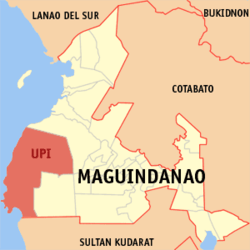Upi, Maguindanao
| Upi | |
|---|---|
| Municipality | |
 Map of Maguindanao showing the location of Upi | |
.svg.png) Upi Location within the Philippines | |
| Coordinates: 7°1′44″N 124°9′54″E / 7.02889°N 124.16500°ECoordinates: 7°1′44″N 124°9′54″E / 7.02889°N 124.16500°E | |
| Country |
|
| Region | Autonomous Region in Muslim Mindanao (ARMM) |
| Province | Maguindanao |
| Founded | June 10, 1955 |
| Barangays | 23 |
| Government[1] | |
| • Mayor | Ramon A. Piang Sr. |
| Area | |
| • Total | 742.95 km2 (286.85 sq mi) |
| Population (2010) | |
| • Total | 45,444 |
| • Density | 61/km2 (160/sq mi) |
| Time zone | PST (UTC+8) |
| ZIP code | 9602 |
| Dialing code | +63 (0)64 |
| Income class | 1st |
| Website |
www |
Upi is a 1st class municipality in the province of Maguindanao, Philippines. According to the 2010 census, it has a population of 45,444 people in 11,337 households.
The town was part of the province of Shariff Kabunsuan from October 2006 until its nullification by the Supreme Court in July 2008.
Barangays
Upi is politically subdivided into 23 barangays.
- Bantek
- Bayabas
- Blensong
- Borongotan
- Bugabungan
- Bungcog
- Darugao
- Ganasi
- Kabakaba
- Kibleg
- Kibucay
- Kiga
- Kinitaan
- Mirab
- Nangi/Kamonsawi
- Nuro (Poblacion)
- Ranao Pilayan
- Rempes
- Renede
- Renti
- Rifao
- Sefegefen
- Tinungkaan
Etymology
Upi was probably derived from the term "ufi". It is a Teduray name for a certain tree that grows abundantly in the place in the early years. The bark of “Ufi” is used with betel nuts for chewing or "mama" in Teduray. Tedurays are the native inhabitants of the place.
History
The beginning of Upi as a district geographical and political entity largely began on the early part of 1901 to 1910 when the American forces set foot in the then Empire of Cotabato. Today the province is subdivided into five (5) major provinces: Sultan Kudarat, Cotabato, South Cotabato, Saranggani and Maguindanao where Upi municipality is located. Upi is a mountainous town situated in the south-western coastal portion of Maguindanao Province.
Known far and wide, an American Army Officer Captain Irving Bryant Edwards was assigned in Awang. He showed great interest in bringing the government closer to the people by establishing schools in the far-flung areas. He reached the fertile valley of Upi and founded the Upi Agricultural School on August 19, 1919. From a USAFFE soldier, Capt. Irving Bryant Edwards turned educator.
Upi was formerly a barrio of Dinaig (part of the province of Cotabato then). It was separated from the said town by virtue of Republic Act No. 1248, approved June 10, 1955.[2]
The first Municipal Mayor, Vice Mayor and Councilors of Upi were appointed by the President of the Philippines to hold office. Maria Badoy was appointed as the first Municipal Mayor. In 1956, the citizens were encouraged to participate in the political affairs of the local government and there took place the first election wherein Mayor Ignacio Tenorio Labina, a Teduray leader, was the first elected mayor of Upi and held his office for four years.
The current mayor of Upi is Ramon A. Piang Sr., a former principal of Notre Dame of Upi, a local high school managed by the Archdiocesan Notre Dame Schools of Cotabato.
- Maria Badoy - 1955 - 1956 - Appointed Mayor
- Ignacio Tenorio Labina - 1956 - 1960 - First Elected Mayor
- Datu Abdullah "Ugcog" Sinsuat - 1960 - 1963 - Elected Mayor
- Datu Michael "Puti" P. Sinsuat - 1963 - 1980 - Elected Mayor
- Bai Fatima P. Sinsuat -1980 - 1986- Elected Mayor
- Datu Mohammad "Unting" Sinsuat - 1986 - 1987- Appointed Mayor
- Datu Mohammad "Unting" Sinsuat - 1987 - 1992- Elected Mayor
- Datu Michael "Puti" P. Sinsuat -1992 - 2001- Elected Mayor
- Ramon A. Piang, Sr. -2001 - 2010 - Elected Mayor
- Ruben D. Platon -2010-2011 - Elected Mayor
- Ramon A. Piang, Sr 2011 - present Appointed Mayor
Demographics
| Population census of Upi | ||
|---|---|---|
| Year | Pop. | ±% p.a. |
| 1990 | 45,957 | — |
| 1995 | 46,440 | +0.20% |
| 2000 | 51,141 | +2.09% |
| 2007 | 41,757 | −2.76% |
| 2010 | 45,444 | +3.13% |
| Source: National Statistics Office[3] | ||
Meguyaya Festival
Meguyaya, a Teduray term for thanksgiving for the bountiful harvest, is an annual festival celebrated every December. The festivities incorporate street dancing competition depicting tri-people culture, Teduray, Moro and Settlers . Other activities includes the Cultural Nights, Local Government Unit Night, Ginoong Meguyaya male pageant, trade fair and Maisan Na. This is an activity in which a long stretch of grillers are placed by the roadside where everyone enjoys roasting corns, a symbol of togetherness and feasting.
References
- ↑ "Official City/Municipal 2013 Election Results". Intramuros, Manila, Philippines: Commission on Elections (COMELEC). 1 July 2013. Retrieved 5 September 2013.
- ↑ "An Act to Create the Municipality of Upi in the Province of Cotabato". LawPH.com. Retrieved 2011-04-11.
- ↑ "Total Population by Province, City, Municipality and Barangay: as of May 1, 2010". 2010 Census of Population and Housing. National Statistics Office. Retrieved 6 October 2013.
External links
- Brief history of Upi
- Philippine Standard Geographic Code
- Philippine Census Information
- Local Governance Performance Management System
 |
Datu Odin Sinsuat |  | ||
| Datu Blah T. Sinsuat | |
Datu Odin Sinsuat | ||
| ||||
| | ||||
| South Upi |